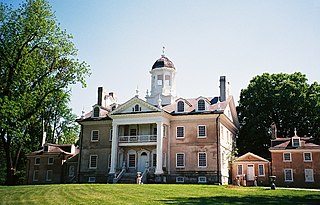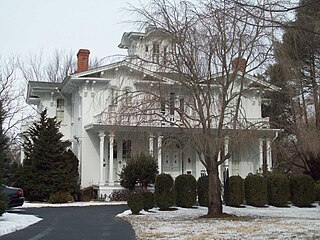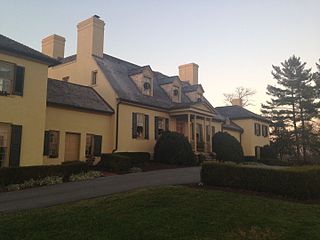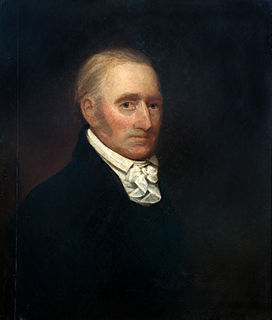
George Howard was the 22nd Governor of the State of Maryland in the United States from 1831 to 1833. Howard was well known as a fervent anti-Jacksonian during his term in office. He was the only son of a governor to have been elected governor.

Druid Hill Park is a 745-acre (3.01 km2) urban park in northwest Baltimore, Maryland. Its boundaries are marked by Druid Park Drive (north), Swann Drive and Reisterstown Road, and the Jones Falls Expressway / Interstate 83 (east).

Hampton National Historic Site, in the Hampton area north of Towson, Baltimore County, Maryland, USA, preserves a remnant of a vast 18th-century estate, including a Georgian manor house, gardens, grounds, and the original stone slave quarters. The estate was owned by the Ridgely family for seven generations, from 1745 to 1948. The Hampton Mansion was the largest private home in America when it was completed in 1790 and today is considered to be one of the finest examples of Georgian architecture in the U.S. Its furnishings, together with the estate's slave quarters and other preserved structures, provide insight into the life of late 18th-century and early 19th-century landowning aristocracy. In 1948, Hampton was the first site selected as a National Historical Site for its architectural significance by the U.S. National Park Service. The grounds were widely admired in the 19th century for their elaborate parterres or formal gardens, which have been restored to resemble their appearance during the 1820s. Several trees are more than 200 years old. In addition to the mansion and grounds, visitors may tour the overseer's house and slave quarters, one of the few plantations having its original slave quarters surviving to the present day.

Charles Carnan Ridgely was born Charles Ridgely Carnan. He is also known as Charles Ridgely of Hampton. He served as the 15th Governor of the state of Maryland in the United States from 1815 to 1818. He also served in the Maryland House of Delegates from 1790 to 1795, and in the Maryland State Senate from 1796 to 1800. Charles was born in Baltimore. He was the son of John Carnan and Achsah Ridgely, sister of Captain Charles Ridgely. The Maryland Gazette described him as an aristocrat.

Col. Charles Ridgely II, "Charles The Merchant" (1702–1772), of "Ridgely's Whim", was a Justice, planter, merchant, ironmaster, and member of the General Assembly of Maryland's lower chamber, House of Delegates and one of Baltimore County's commissioners. Charles II was the son of Charles Ridgely I,, , and Deborah Dorsey.

The Poplar Hill Mansion is a historic U.S. mansion located at 117 Elizabeth Street, Salisbury, Maryland and is open to the public as a house museum.

His Lordship's Kindness, also known as Poplar Hill, is a historic plantation estate on Woodyard Road east of Clinton, Maryland. It was built in the 1780s for Prince George's County planter Robert Darnall. The five-part Georgian mansion retains a number of subsidiary buildings including a slave's hospital and a dovecote. The property is now operated as a museum by a local nonprofit preservation group. It was designated a National Historic Landmark in 1970.

Riversdale, is a five-part, large-scale late Georgian mansion with superior Federal interior, built between 1801 and 1807. Also known as Baltimore House, Calvert Mansion or Riversdale Mansion, it is located at 4811 Riverdale Road in Riverdale Park, Maryland, and is open to the public as a museum.

Dorsey Hall is a historic home in Columbia, Maryland, United States. It is a six-by-one-bay, 2+1⁄2-story stucco structure with a gable roof covered with asphalt shingles. It is a well-preserved and detailed example of the vernacular dwellings of the early 19th century in Howard County and associated with the Dorsey family, one of the "first families" of the county.

Temora, is a historic home located at Ellicott City, Howard County, Maryland. It is a T-shaped, two-story and cupola, Tuscan-style Victorian house of stuccoed tongue-and-groove boards. The house was built in 1857 after a design prepared by Nathan G. Starkweather, a little-known but accomplished architect from Oxford, England, who also designed the First Presbyterian Church and Manse at West Madison Street and Park Avenue in the Mount Vernon-Belvedere neighborhood in Baltimore, Maryland, with his later more famous assistant - Edmund G. Lind. The house was built for Dr. Arthur Pue Jr. on land given from his grandmother Mary Dorsey Pue of Belmont Estate. The name of the estate Temora comes from the poems of Ossian

Troy, also known as Troy Hill Farm, is a historic slave plantation home located at Elkridge, Howard County, Maryland, United States. It is associated with the prominent Dorsey family of Howard County, who also built Dorsey Hall.

Waverly Mansion is a historic home located at Marriottsville in Howard County, Maryland, USA. It was built circa 1756, and is a 2+1⁄2-story Federal style stone house, covered with stucco, with a hyphen and addition that date to circa 1811. Also on the property are a small 1+1⁄2-story stone overseer's cottage and a 2-story frame-and-stone barn, and the ruins of a log slave quarter.

Rose Hill Manor, now known as Rose Hill Manor Park & Children's Museum, is a historic home located at Frederick, Frederick County, Maryland. It is a 2+1⁄2-story brick house. A notable feature is the large two-story pedimented portico supported by fluted Doric columns on the first floor and Ionic columns on the balustraded second floor. It was the retirement home of Thomas Johnson (1732–1819), the first elected governor of the State of Maryland and Associate Justice of the United States Supreme Court. It was built in the mid-1790s by his daughter and son-in-law.

Raspberry Plain is a historic property and former plantation in Loudoun County, Virginia, near Leesburg. Raspberry Plain became one of the principal Mason family estates of Northern Virginia, and was rebuilt in the early 20th century. It currently operates as an event site, hosting weddings and other special events year round.
Baltimore Heritage is an American nonprofit historic-preservation organization headquartered in Baltimore, Maryland.

The Belmont Estate, now Belmont Manor and Historic Park, is a former forced-labor farm located at Elkridge, Howard County, Maryland, United States. Founded in the 1730s and known in the Colonial period as "Moore's Morning Choice", it was one of the earliest forced-labor farms in Howard County, Maryland. Its 1738 plantation house is one of the finest examples of Colonial Georgian architectural style in Maryland.

Harry Dorsey Gough was a prominent 18th-century merchant, planter, and patron of the fledgling Methodist Church in Baltimore, Maryland, in the early United States.
Montpelier Mansion, sometimes referred to as "Montpelier I", was a house in western Laurel, Maryland, now more closely associated with Fulton, Maryland within Howard County, Maryland, United States. The Georgian style building was built circa 1740 and demolished following a 1994 historic survey with addendum and photos dating as late as August 1995.
Located Cooksville in Howard County, Maryland, United States, Poverty Discovered, "Summer Hill Farm"
Troy Park is a regional park comprising 101 acres in Elkridge, Maryland. The park is located at 6500 Mansion Lane off Washington Boulevard, near the intersection of Maryland Route 100 and I-95.






















